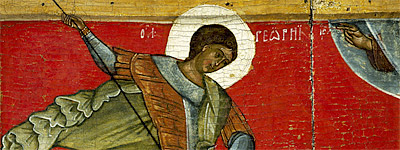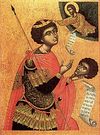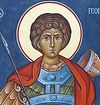 Apostles of the Seventy Erastus, Olympas, Herodion, Sosipater, Quartus, and Tertius (Terence) (1st c.).
Apostles of the Seventy Erastus, Olympas, Herodion, Sosipater, Quartus, and Tertius (Terence) (1st c.).
Commemoration of the beginning of the torture of Great-martyr George (303). Martyr Orestes the Physician, of Cappadocia (304). Hieromartyr Milos (Miles), bishop in Persia, and his disciples, Martyrs Aborsam and Senoe (ca. 341). Great-martyr Constantine-Kakhi, prince of Kartli, Georgia (852). St. Theocteristus, abbot, of Symbola Monastery on Mt. Olympus in Bithynia. Glorification of St. Matthew, monk, of Yaransk (1997).
New Hieromartyrs Procopius (Titov), archbishop of Kherson, Seraphim (Gushchin), hieromonk of Optina Monastery, and Peter Pavlushkov, archpriest, of Tula (1937). New Hieromartyrs Augustine (Belyaev), archbishop of Kaluga, and with him Ioannicius (Dmitriev), archimandrite, of the St. George Monastery (Meshchevsk), Niphon (Vyblov), hieromonk, of Berezovy Khutor (Saratov), and John Speransky, archpriest, of Kaluga (1937). New Martyrs Alexis Gorbachev, Apollonius Babichev. and Michael Arefeyev, Nicholas Smirnov, Anna Ostroglazova (1937-1939). New Martyrs Olga Maslennikova (1941) and Theoctista Chentsova (1942).
St. Eucharius, first bishop of Trier (3rd c.). St. Nonnus, bishop of Heliopolis (471). St. Justus, archbishop of Canterbury (627- 631). Ten Martyrs of Gaza, at Jerusalem: Callinius, Imerius, Diasimus, Theodore, Stephen, Peter, Paul, Theodore, John, and John (638). Translation of the relics of St. Gregory, bishop of Assos near Ephesus (1150).
Saturday. [Gal. 1:3-10; Luke 9:37-43]
After coming down from the mount of the
Transfiguration, the Lord heals a youth possessed with a
devil. A reproach for unbelief preceded the healing, as
the reason why the misfortunate one was not healed by the
disciples. Whose unbelief this was—whether of the
father who brought his son, of the people who gathered
together, or perhaps of the Apostles—it is seen only
that unbelief closes the doors to God’s merciful
intercession and help, whereas faith opens it. The Lord
said to the father: as much as you can believe, so you
will receive. Faith is not just a matter of thought and
mind, when it relates to a person, but embraces the entire
essence of man. It is a mutual obligation of the believer
and the One in Whom he believes, though it might not be
expressed literally. He who believes counts on the one he
believes in for everything, and does not expect a refusal
from him in anything. That is why he turns to him with
undivided thought, like to a father, goes to him as to his
treasure chamber, with the surety that he will not return
empty. Such an attitude inclines without words the one
towards whom this attitude is held. This is how it is with
people. But the power of dispositions is truly manifest
when they are directed toward the Lord, Who is almighty,
omniscient and desires to give us every good; and a true
believer’s expectations are never betrayed. If we do
not have something, and do not receive it when we ask for
it, it is because we do not have the proper faith. First
and foremost we must seek and introduce in our heart
complete faith in the Lord, seek and obtain it of Him
through our entreaties, for it comes not from us, but is
God’s gift. When faith was required from the father
of the youth, he prayed: “Lord, I believe; help thou
mine unbelief.” He believed weakly, wavering, and
prayed about the strengthening of faith. But who can boast
of such perfect faith as his, and who, therefore, does not
need to pray, “Help, O Lord, mine unbelief?”
If only the full force of faith were in us, our thoughts
would be pure and feelings holy, and deeds God-pleasing.
Then the Lord would heed us like a father his children;
and no matter what comes to our heart—and what would
come to a person in this state could only be pleasing to
the Lord—we would receive everything without refusal
or delay.


![]() Apostles of the Seventy Erastus, Olympas, Herodion, Sosipater, Quartus, and Tertius (Terence) (1st c.).
Apostles of the Seventy Erastus, Olympas, Herodion, Sosipater, Quartus, and Tertius (Terence) (1st c.). 


















